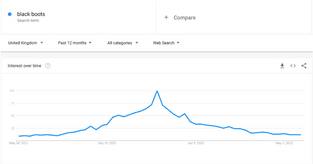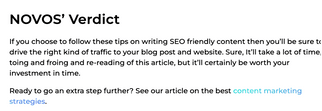It should go without saying that content is a key part of eCom SEO. It helps to improve your search presence, legitimise your site to Google and bring in new potential customers.
There are a number of ways to incorporate content on your website, including PDPs, blogs and title tags. You also want to ensure that you have the perfect balance of improved search performance and a great user experience.
Creating valuable content is a fantastic way to connect with your audience, especially through blog articles. A blog isn’t just about pushing your products. You can also share staff interviews and valuable information about different aspects of your business.
Find out all the reasons why content is good for eCommerce SEO.
1. Topic Research Is Key for Opportunity
First things first, you need to have an idea of what type of content you are going to write about. As much as keywords are a vital factor in SEO and SERPs, so is relevancy. There are many ways you can find what you need to write about. There has been a sharp increase in social eCommerce and the importance of purchasing from trusted companies.
You can use your social media platforms, including Instagram, to ask what your customers want to see more of. This way, you build the engagement and find out what is going to be valuable to them.
Quora and Google Trends can also be great additions to your topical research. Quora gives you access to a wide range of information, whilst Google Trends shows the interest levels across search terms over time.
2. Content Needs Keyword Research
Now you have chosen your topic, it is time to carry out some keyword research. Tools such as Semrush and Google Keyword Planner allow you to find search terms that people are looking for.
The customer journey is especially important when it comes to keyword research. You want to choose the right search term that is going to benefit the customers at each stage of their eCom journey. For example, if you sell black boots and you want to reach people at the start of the process, you could target “stylish black boots”. However, if you wanted to target people after purchase, you could focus on “what to wear with black boots”. This is a good way to get people back through the purchasing funnel for another product, e.g. black jeans.
Long-tail keywords, despite having a low search volume, may also have low competition. This allows you to reach page one in the search results page a lot easier. Long-tail keywords are also specific, meaning you can answer your customers’ questions and pain points and drive them to your eCommerce store.
3. Don’t Forget About The EAT Framework
In recent years, we have seen many eCommerce brands build their customer relationships through various means. The E-A-T framework is a key example of why content is good for SEO.
This is very important for search engine optimization (SEO), allowing your blog to get noticed on Google and build awareness of your brand. E-A-T stands for Expertise, Authority and Trust.
In your blog, you can create content that hits all of these three pillars. You can do this by curating content that answers your customers’ questions, which is something that people share. To learn more about E-A-T, read our handy E-A-T Guide.
4. Writing Content for Humans
As well as ensuring your content is SEO friendly, you also want to keep readers invested. You may have done all the right things to be seen on Google, but you want readers to keep looking through your website.
When writing content, as well as keeping in mind the topic and keyword, you have to write for humans. You don’t want your readers to think “is this for us?”. Using relative and personal language will keep your audience engaged and their trust high. This also helps Google to understand what the content is about and show it to the right people.
5. Content Needs a Good Title Tag & Meta Description
Title tags and meta descriptions are an important part of having eCom SEO-friendly content. They help Google to understand the content and will appear on search results to give readers more information about the page and your store.
We recommend you have your targeted keyword in both the title tag and the meta description. Your brand name will also fit nicely at the end of the title tag, whilst we advise a strong call to action for the end of your meta description.
6. Linking: Internal & External Links for Content
Having a strong internal and external linking structure on your website is key for user experience and search presence, especially for eCom SEO. By placing navigational & internal links on your site to other pages on your website, you can help search engines to understand the relationship between two pages. Contextual links within the text can give Google an idea of the content of your internal link and rank it for relevant search terms.
External linking may seem counterintuitive as you want people to stay on your website. However, by linking to external sites from your website, you can build up your credibility and increase the value you give to your customers. Adding external links from your high-quality blog post to another high-quality page can help Google to understand your page, therefore improving the SEO value of your website.
7. Structure Your Content Effectively
When you write content for your site, you need to ensure that it has a strong structure. Ideally, you don’t want a page with too much space or too much text without some sort of visual element (e.g. a photo or infographic). This impacts user experience.
It is best practice to have one main header (which will be your H1 tag) and any other sections with a subheading (your h2 tag). This also helps Google to understand the layout of your page, which increases its quality. Whichever CMS you use, it should be fairly simple to choose the type of header you wish. If you are inputting the header elements in code, this is what you need to input:
<h1>Heading</h1>
<h2>Subheading</h2>
<h3>subheading</h3>
<h4>subheading</h4>
8. eCom SEO Needs a Strong Call to Action
One of the most essential parts of content is a strong call to action. This can vary on the type of page & acquisition funnel that you are writing for. Let’s think about a blog post. If you are looking to increase sales of shoes, you could write a blog post about “10 Styles of Black Shoes”, and the call to action could be “Take a look at our black shoe range” and link to the relevant category.
You may also want to provide your customers with valuable information post-sales. For example, you could create this post for people who just bought off your site “How to clean black shoes”. The call to action could look something like this, “check out the best ways to style black shoes”. This can also help to improve your internal linking strategy. See below how we use call to actions at the bottom of our blog posts.
9. User-Friendly Content
Once you have written compelling content for your website, you want to check that your customers are going to navigate it easily. If readers are having trouble using your website, this isn’t great for user experience or eCom SEO.
In May 2020, Google announced their Core Web Vitals update, which took place in June 2021. Google now takes into consideration site speed when it comes to ranking factors. There are many tools you can use, including Google Search Console and PageSpeed insights to check your URLs. This can be tricky, so you may need a developer to help.
By taking the time to implement these tips, you can curate content on your website that is delivered to the right people whilst improving its search presence. It may take time, however, you can attract and retain new customers for your business, whilst delivering valuable information.
A final note from us, you don’t always have to create new content each month. Optimising older content, especially on blogs, can help to improve drive more SEO traffic to your website. Find out more about how to pull more SEO traffic through old blog posts.



